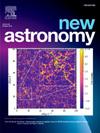重力幂律f(G)下的物质功率谱
IF 2.1
4区 物理与天体物理
Q2 ASTRONOMY & ASTROPHYSICS
引用次数: 0
摘要
基于f(G)引力的宇宙学模型在背景和扰动水平上都能有效地拟合不同的观测数据集。这促使当前的研究考虑动力系统分析来研究修正高斯-邦纳引力框架下的物质功率谱。在定义幂律f(G)模型的无量纲动力系统变量后,我们使用1+3协变形式导出了控制物质和高斯-邦纳流体能量密度扰动的完整方程组。在解出能量密度微扰方程后,计算出物质功率谱。强调了研究f(G)模型的一阶微扰的重要性以及不同初始条件在计算物质功率谱中的相关性。据报道,对于f(G)模型的特定函数形式,f(G)引力的物质功率谱不像广义相对论那样是尺度不变的。本文章由计算机程序翻译,如有差异,请以英文原文为准。
Matter power spectrum in a power-law f(G) gravity
Cosmological models based on gravity are efficient in fitting different observational datasets at both background and perturbation levels. This motivates the current study to take into account dynamical system analysis to investigate the matter power spectrum within the framework of modified Gauss–Bonnet gravity. After defining the dimensionless dynamical system variables for a power-law model, We derive the full system of equations governing the energy density perturbations for both matter and Gauss–Bonnet fluids using the covariant formalism. After solving the energy density perturbation equations, we compute the matter power spectrum. The importance of studying first order perturbations for the defined model and the relevance of different initial conditions in computing the matter power spectrum are also stressed. It is reported that matter power spectrum for gravity, for a particular functional form of model considered is not scale invariant as the case for General Relativity.
求助全文
通过发布文献求助,成功后即可免费获取论文全文。
去求助
来源期刊

New Astronomy
地学天文-天文与天体物理
CiteScore
4.00
自引率
10.00%
发文量
109
审稿时长
13.6 weeks
期刊介绍:
New Astronomy publishes articles in all fields of astronomy and astrophysics, with a particular focus on computational astronomy: mathematical and astronomy techniques and methodology, simulations, modelling and numerical results and computational techniques in instrumentation.
New Astronomy includes full length research articles and review articles. The journal covers solar, stellar, galactic and extragalactic astronomy and astrophysics. It reports on original research in all wavelength bands, ranging from radio to gamma-ray.
 求助内容:
求助内容: 应助结果提醒方式:
应助结果提醒方式:


